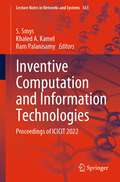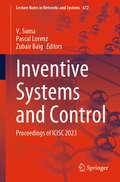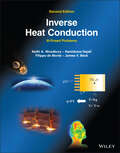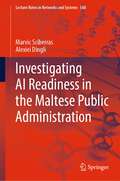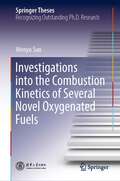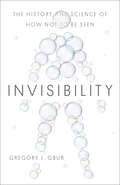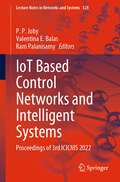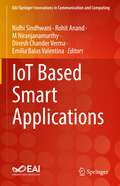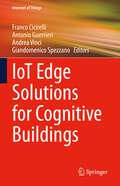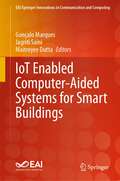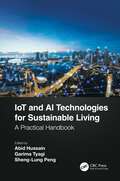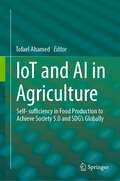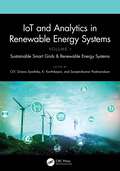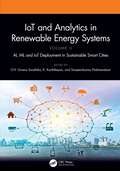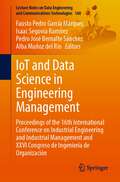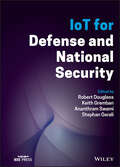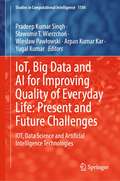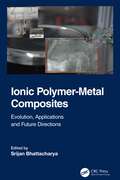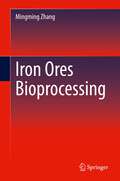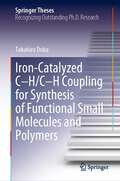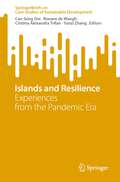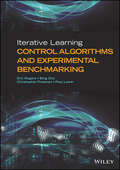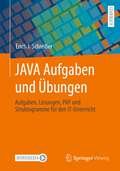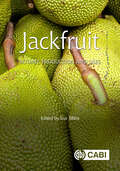- Table View
- List View
Inventive Computation and Information Technologies: Proceedings of ICICIT 2022 (Lecture Notes in Networks and Systems #563)
by S. Smys Ram Palanisamy Khaled A. KamelThis book is a collection of best selected papers presented at the Fourth International Conference on Inventive Computation and Information Technologies (ICICIT 2022), organized during August 25–26, 2022. This book includes papers in the research area of information sciences and communication engineering. This book presents novel and innovative research results in theory, methodology and applications of communication engineering and information technologies.
Inventive Systems and Control: Proceedings of ICISC 2023 (Lecture Notes in Networks and Systems #672)
by Pascal Lorenz Zubair Baig V. SumaThis book presents selected papers from the 7th International Conference on Inventive Systems and Control (ICISC 2023), held on January 30–31, 2023, at JCT College of Engineering and Technology, Coimbatore, India. The conference proceedings of ICISC 2023 include an analysis of the class of intelligent systems and control techniques that utilizes various artificial intelligence technologies, where there are no mathematical models and system available to make them remain controlled. Inspired by various existing intelligent techniques, the primary goal of ICISC 2023 proceedings is to present the emerging innovative models to tackle the challenges faced by the existing computing and communication technologies.
Inverse Heat Conduction: Ill-Posed Problems
by James V. Beck Hamidreza Najafi Keith A. Woodbury Filippo de MonteInverse Heat Conduction A comprehensive reference on the field of inverse heat conduction problems (IHCPs), now including advanced topics, numerous practical examples, and downloadable MATLAB codes. The First Edition of the classic book Inverse Heat Conduction: III-Posed Problems, published in 1985, has been used as one of the primary references for researchers and professionals working on IHCPs due to its comprehensive scope and dedication to the topic. The Second Edition of the book is a largely revised version of the First Edition with several all-new chapters and significant enhancement of the previous material. Over the past 30 years, the authors of this Second Edition have collaborated on research projects that form the basis for this book, which can serve as an effective textbook for graduate students and as a reliable reference book for professionals. Examples and problems throughout the text reinforce concepts presented. The Second Edition continues emphasis from the First Edition on linear heat conduction problems with revised presentation of Stolz, Function Specification, and Tikhonov Regularization methods, and expands coverage to include Conjugate Gradient Methods and the Singular Value Decomposition method. The Filter Matrix concept is explained and embraced throughout the presentation and allows any of these solution techniques to be represented in a simple explicit linear form. Two direct approaches suitable for non-linear problems, the Adjoint Method and Kalman Filtering, are presented, as well as an adaptation of the Filter Matrix approach applicable to non-linear heat conduction problems. In the Second Edition of Inverse Heat Conduction: III-Posed Problems, readers will find: A comprehensive literature review of IHCP applications in various fields of engineering Exact solutions to several fundamental problems for direct heat conduction problems, the concept of the computational analytical solution, and approximate solution methods for discrete time steps using superposition of exact solutions which form the basis for the IHCP solutions in the text IHCP solution methods and comparison of many of these approaches through a common suite of test problems Filter matrix form of IHCP solution methods and discussion of using filter-form Tikhonov regularization for solving complex IHCPs in multi-layer domain with temperature-dependent material properties Methods and criteria for selection of the optimal degree of regularization in solution of IHCPs Application of the filter concept for solving two-dimensional transient IHCP problems with multiple unknown heat fluxes Estimating the heat transfer coefficient, h, for lumped capacitance body and bodies with temperature gradients Bias in temperature measurements in the IHCP and correcting for temperature measurement bias Inverse Heat Conduction is a must-have resource on the topic for mechanical, aerospace, chemical, biomedical, or metallurgical engineers who are active in the design and analysis of thermal systems within the fields of manufacturing, aerospace, medical, defense, and instrumentation, as well as researchers in the areas of thermal science and computational heat transfer.
Investigating AI Readiness in the Maltese Public Administration (Lecture Notes in Networks and Systems #568)
by Alexiei Dingli Marvic SciberrasThe book presents a unique study on the Artificial Intelligence (AI) readiness of public administrations focusing on the Maltese public administration as a case study. This was conducted following the launch of the Malta AI National Strategy in 2019. Since the Maltese public administration is the driving force behind the integration of AI solutions nationwide, the research is deemed necessary to understand whether the public workforce itself is ready to face the oncoming AI revolution. The researchers applied a mixed-methods approach to gain insight and a broader perspective of the status quo concerning AI adoption. Important considerations that stem from this study include the need for increased AI knowledge among public administrators since the majority of respondents reported a lack of awareness of AI technologies and their deployment. Understanding AI-related advantages must be accompanied by a robust instructional effort at all levels of education. It was unanimously agreed that the early inclusion of AI-related courses in the Maltese educational system will aid in developing a future AI-savvy workforce. Furthermore, upskilling and reskilling the public officers will facilitate knowledgeable human capital and proficiencies required to effectively integrate AI solutions within society. The study concludes by recommending several critical reforms within governments that will improve the AI-readiness factor of any Public Administration.
Investigations into the Combustion Kinetics of Several Novel Oxygenated Fuels (Springer Theses)
by Wenyu SunIn this thesis, attention was paid to several novel oxygenated fuels—carbonates, polyethers and ketones. Combustion kinetic investigations were performed for typical representative compounds, including dimethyl carbonate, diethyl carbonate, cyclopentanone, 3-pentanone, 1,2-dimethoxyethane and dimethoxymethane. For experiments, suitable diagnostic techniques were used to measure the detailed speciation information of the target fuels under different conditions. For kinetic modeling, rate coefficients for crucial elementary reactions were obtained through high-level theoretical calculations. Based on that, validated kinetic models with good predictive performances were developed. On the basis of experimental measurements and model interpretations, this work highlighted two important combustion characteristics regarding the practical use: the pollutant formation and the ignition performance. Besides, the correlation between oxygen-containing functional groups and the aforementioned combustion characteristics was revealed. To reveal the potential interactions between the reaction networks of oxygenated additives and the hydrocarbon base fuels during combustion. Chemical structures of laminar premixed flames fueled by binary fuels were measured, and by changing the initial fuel compositions, the addition effects of the oxygenates on the fuel consumption and pollutant formation behaviors were explored. It was found that complicated chemical interactions do not exist in the reaction networks under the investigated conditions.
Invisibility: The History and Science of How Not to Be Seen
by Gregory J. GburA lively exploration of how invisibility has gone from science fiction to fact Is it possible for something or someone to be made invisible? This question, which has intrigued authors of science fiction for over a century, has become a headline-grabbing topic of scientific research. In this book, science writer and optical physicist Gregory J. Gbur traces the science of invisibility from its sci-fi origins in the nineteenth-century writings of authors such as H. G. Wells and Fitz James O&’Brien to modern stealth technology, invisibility cloaks, and metamaterials. He explores the history of invisibility and its science and technology connections, including the discovery of the electromagnetic spectrum, the development of the atomic model, and quantum theory. He shows how invisibility has moved from fiction to reality, and he questions the hidden paths that lie ahead for researchers. This is not only the story of invisibility but also the story of humankind&’s understanding of the nature of light itself, and of the many fascinating figures whose discoveries advanced this knowledge.
IoT Based Control Networks and Intelligent Systems: Proceedings of 3rd ICICNIS 2022 (Lecture Notes in Networks and Systems #528)
by Valentina E. Balas Ram Palanisamy P. P. JobyThis book gathers selected papers presented at International Conference on IoT Based Control Networks and Intelligent Systems (ICICNIS 2022), organized by St. Joseph’s College of Engineering and Technology, Kottayam, Kerala, India, during July 1–2, 2022. The book covers state-of-the-art research insights on Internet of things (IoT) paradigm to access, manage, and control the objects/things/people working under various information systems and deployed under wide range of applications like smart cities, health care, industries, and smart homes.
IoT Based Smart Applications (EAI/Springer Innovations in Communication and Computing)
by Dinesh Chander Verma Nidhi Sindhwani Rohit Anand M Niranjanamurthy Emilia Balas ValentinaThis book provides insights into IoT, its applications, and various implementation techniques. The authors first discuss the IoT design methodology to define the domain model. They then cover various connection methodologies used in IoT such as Ethernet, Wi-Fi, low powered wide area network (LPWAN), Bluetooth, RFID, cellular, and satellite, and more, along with their challenges. An example is made on the designing process using Arduino, which offers smart, connected, and secure elements; they also illustrate the integration of IoT with Blockchain, cloud, machine learning, big data, embedded software, sensors, etc. The book going on to cover the future of IoT in various sectors and how IoT will continue to be game-changing technology.
IoT Edge Solutions for Cognitive Buildings (Internet of Things)
by Antonio Guerrieri Giandomenico Spezzano Franco Cicirelli Andrea VinciThis book outlines the promise of the field of the Cognitive Internet of Things when it is applied to cognitive buildings. After an introduction, the authors discuss the goals of cognitive buildings such as operation in a more efficient, flexible, interactive, intuitive, and sustainable way. They go on to outline the benefits that these technologies promise to building owners, occupants, and their environments that range from reducing energy consumption and carbon footprint to promoting health, well-being, and productivity. The authors outline technologies that provide buildings and equipment with the ability to collect, aggregate, and analyze data and how this information can be collected by sensors and related to internal conditions and settings, energy consumption, user requests, and preferences to maintain comfort and save energy. This book is of interest to practitioners, researchers, students, and professors in IoT and smart cities.
IoT Enabled Computer-Aided Systems for Smart Buildings (EAI/Springer Innovations in Communication and Computing)
by Maitreyee Dutta Gonçalo Marques Jagriti SainiThis book focuses on the integration of IoT and computer aided systems for the development of smart buildings. The scope of the book includes, but is not restricted to, advanced technologies for monitoring, energy management, smart gardening, protection, safety, assisted living, and intelligent operations. The authors cover the wide aspects of interconnected smart services with convenient interfacing to the end-users. The features of this book include discussion on various aspects of IoT and computer aided systems for smart architecture designs and innovative object interconnections. The book also provides highlights on the applications of IoT in the development of intelligent structures for technology-enabled lifestyles. Furthermore, it provides prominent scopes for future inventions in the field of electrical engineering, building system management, and computer-aided advancements. The content of this book is useful to graduate and post-graduate students, researchers, and professionals working on the concept of smart building, smart city, and smart environments.
IoT and AI Technologies for Sustainable Living: A Practical Handbook
by Abid HussainThis book brings together all the latest methodologies, tools and techniques related to the Internet of Things and Artificial Intelligence in a single volume to build insight into their use in sustainable living. The areas of application include agriculture, smart farming, healthcare, bioinformatics, self-diagnosis systems, body sensor networks, multimedia mining, and multimedia in forensics and security. This book provides a comprehensive discussion of modeling and implementation in water resource optimization, recognizing pest patterns, traffic scheduling, web mining, cyber security and cyber forensics. It will help develop an understanding of the need for AI and IoT to have a sustainable era of human living. The tools covered include genetic algorithms, cloud computing, water resource management, web mining, machine learning, block chaining, learning algorithms, sentimental analysis and Natural Language Processing (NLP). IoT and AI Technologies for Sustainable Living: A Practical Handbook will be a valuable source of knowledge for researchers, engineers, practitioners, and graduate and doctoral students working in the field of cloud computing. It will also be useful for faculty members of graduate schools and universities.
IoT and AI in Agriculture: Self- sufficiency in Food Production to Achieve Society 5.0 and SDG's Globally
by Tofael AhamedThis book reviews recent innovations in the smart agriculture space that use the Internet of Things (IoT) and sensing to deliver Artificial Intelligence (AI) solutionsto agricultural productivity in the agricultural production hubs. In this regard, South and Southeast Asia are one of the major agricultural hubs of the world, facing challenges of climate change and feeding the fast-growing population. To address such challenges, a transboundary approach along with AI and BIG data for bioinformatics are required to increase yield and minimize pre- and post-harvest losses in intangible climates to drive the sustainable development goal (SDG) for feeding a major part of the 9 billion population by 2050 (Society 5.0 SDG 1 & 2). Therefore, this book focuses on the solution through smart IoT and AI-based agriculture including pest infestation and minimizing agricultural inputs for in-house and fields production such as light, water, fertilizer and pesticides to ensure food security aligns with environmental sustainability. It provides a sound understanding for creating new knowledge in line with comprehensive research and education orientation on how the deployment of tiny sensors, AI/Machine Learning (ML), controlled UAVs, and IoT setups for sensing, tracking, collection, processing, and storing information over cloud platforms for nurturing and driving the pace of smart agriculture in this current time. The book will appeal to several audiences and the contents are designed for researchers, graduates, and undergraduate students working in any area of machine learning, deep learning in agricultural engineering, smart agriculture, and environmental science disciplines. Utmost care has been taken to present a varied range of resource areas along with immense insights into the impact and scope of IoT, AI and ML in the growth of intelligent digital farming and smart agriculture which will give comprehensive information to the targeted readers.
IoT and Analytics in Renewable Energy Systems (Volume 1): Sustainable Smart Grids & Renewable Energy Systems
by O. V. Gnana SwathikaSmart grid technologies include sensing and measurement technologies, advanced components aided with communications and control methods along with improved interfaces and decision support systems. Smart grid techniques support the extensive inclusion of clean renewable generation in power systems. Smart grid use also promotes energy saving in power systems. Cyber security objectives for the smart grid are availability, integrity and confidentiality. Five salient features of this book are as follows: AI and IoT in improving resilience of smart energy infrastructure IoT, smart grids and renewable energy: an economic approach AI and ML towards sustainable solar energy Electrical vehicles and smart grid Intelligent condition monitoring for solar and wind energy systems
IoT and Analytics in Renewable Energy Systems (Volume 2): AI, ML and IoT Deployment in Sustainable Smart Cities
by Sanjeevikumar Padmanaban K. Karthikeyan O. V. Gnana SwathikaSmart cities emanate from a smart renewable-energy-aided power grid. The smart grid technologies offer an array of benefits like reliability, availability, and resiliency. Smart grids phenomenally contribute to facilitating cities reaching those sustainability goals over time. Digital technologies, such as the Internet of Things (IoT), automation, artificial intelligence (AI) and machine learning (ML) significantly contribute to the two-way communication between utilities and customers in smart cities. Five salient features of this book are as follows: Smart grid to the smart customer Intelligent computing for smart grid applications Novel designs of IoT systems such as smart healthcare, smart transportation, smart home, smart agriculture, smart manufacturing, smart grid, smart education, smart government, smart traffic management systems Innovations in using IoT and AI in improving resilience of smart energy infrastructure Challenges and future research directions of smart city applications
IoT and Data Science in Engineering Management: Proceedings of the 16th International Conference on Industrial Engineering and Industrial Management and XXVI Congreso de Ingeniería de Organización (Lecture Notes on Data Engineering and Communications Technologies #160)
by Fausto Pedro García Márquez Isaac Segovia Ramírez Pedro José Bernalte Sánchez Alba Muñoz del RíoThis book presents the selected research works from the 16th International Conference on Industrial Engineering and Industrial Management in 2022. The conference was promoted by ADINGOR (Asociación para el Desarrollo de la Ingeniería de Organización), organized by Ingenium Research Group at Universidad de Castilla-La Mancha, Spain, and it took place on July 7th and 8th, 2022, in Toledo, Spain. The book highlights some of the latest research advances and cutting-edge analyses of real-world case studies on Industrial Engineering and Industrial Management from a wide range of international contexts. It also identifies business applications and the latest findings and innovations in Operations Management and in Decision Sciences.
IoT for Defense and National Security
by Robert DouglassIoT for Defense and National Security Practical case-based guide illustrating the challenges and solutions of adopting IoT in both secure and hostile environments IoT for Defense and National Security covers topics on IoT security, architecture, robotics, sensing, policy, operations, and more, including the latest results from the premier IoT research initiative of the U.S. Defense Department, the Internet of Battle Things. The text also discusses challenges in converting defense industrial operations to IoT and summarizes policy recommendations for regulating government use of IoT in free societies. As a modern reference, this book covers multiple technologies in IoT including survivable tactical IoT using content-based routing, mobile ad-hoc networks, and electronically formed beams. Examples of IoT architectures include using KepServerEX for edge connectivity and AWS IoT Core and Amazon S3 for IoT data. To aid in reader comprehension, the text uses case studies illustrating the challenges and solutions for using robotic devices in defense applications, plus case studies on using IoT for a defense industrial base. Written by leading researchers and practitioners of IoT technology for defense and national security, IoT for Defense and National Security also includes information on: Changes in warfare driven by IoT weapons, logistics, and systems IoT resource allocation (monitoring existing resources and reallocating them in response to adversarial actions) Principles of AI-enabled processing for Internet of Battlefield Things, including machine learning and inference Vulnerabilities in tactical IoT communications, networks, servers and architectures, and strategies for securing them Adapting rapidly expanding commercial IoT to power IoT for defense For application engineers from defense-related companies as well as managers, policy makers, and academics, IoT for Defense and National Security is a one-of-a-kind resource, providing expansive coverage of an important yet sensitive topic that is often shielded from the public due to classified or restricted distributions.
IoT, Big Data and AI for Improving Quality of Everyday Life: IOT, Data Science and Artificial Intelligence Technologies (Studies in Computational Intelligence #1104)
by Arpan Kumar Kar Pradeep Kumar Singh Yugal Kumar Wiesław Pawłowski Sławomir T. WierzchońThis book focuses mainly on the usages of three key technologies: IoT, big data, and AI for various day to day applications. Further, it explores the possibilities of future research based on the usages of latest information systems.This book explores the current research and challenges to be faced by different researchers for building intelligent information solutions using key technologies; IoT, big data, and AI in improving quality of lives in smart cities and explores the limitations and capabilities of these three key computing technologies. The book is organized into three major parts; each part includes chapters exploring a specific topic, and there are: PART-1: IoT for Real World Solutions , (ii) Part-2: Big Data And Cloud Computing for Innovative Solutions For Day to Day Lives, and (iii) Part-3 Artificial Intelligence for Everyday Lives. This book may be useful to the scientists, scholars, and researchers who are working in the field of computer science and engineering, and communication engineering, along with the students in these subjects who are working or willing to work on IoT, big data, and AI technologies for improving quality of everyday life. Specialists as well as student readers find the book chapters encouraging and helpful.IoT, data science & cloud, and AI all are the undergraduate (UG/ bachelor) subjects. Use of these three key technologies for building new applications for better world is helpful for UG and postgraduate (PG/ MS) Programmes students (as an elective and core course). This book may also be very useful for the Ph.D. (research scholars) during their course work and may be used as an instrument to identify the different challenges associated with information systems.
Ionic Polymer-Metal Composites: Evolution, Application and Future Directions
by Srijan BhattacharyaThis book focuses on electro active polymer material known as Ionic Polymer Metal Composite (IPMC) having unique applicability as sensor and actuator which finds extensive use in various domain of engineering and science research. Apart from fundamentals of the IPMC concept, various applications are covered extensively across the chapters including space, underwater and nanoscale, including manufacturing processes. Dedicated chapters are included for robotics and biomedical applications and possible research gaps. Future research perspectives for IPMC are also discussed. Features: Covers principle of Ionic Polymer Metal Composite (IPMC), manufacturing processes, applications, and future possibilities in a systematic manner Highlights IPMC practical applicability in biomedical engineering domain Explores Single-walled carbon nanotubes (SWNT) based IPMC soft actuators Discusses IPMC applications in underwater areas Includes IPMC application in robotics focusing on special compliant mechanism This book is aimed toward researchers, graduate students and professionals in materials and mechanical engineering, robotics, mechatronics, biomedical engineering, and physics.
Iron Ores Bioprocessing
by Mingming ZhangThis book describes leading research in bioengineering for development of novel technologies for ferrous metal extraction. The author includes new developments in molecular biology, biochemistry, microbiology, cell metabolism, and engineering principles and applies them to the conventional iron ore industry - proposing innovative solutions to various industry challenges. The book focuses on applied approaches and describes emerging and established industrial processes, as well as the underlying theory of the process, and the biology of the microorganisms involved.Elaborates on bioprocessing technologies applicable for extraction of ferrous metals using cross-pollination of microbiology and extractive metallurgy;Presents a systematic overview of bioprocessing technologies encompassing laboratory research, pilot scale studies, and industrial process flowsheet design;Provides comprehensive coverage of the engineering principles behind bioprocesses of iron ores including material and energy balances, transport processes, reactions and reactor engineering.
Iron-Catalyzed C-H/C-H Coupling for Synthesis of Functional Small Molecules and Polymers (Springer Theses)
by Takahiro DobaThis thesis describes the development of iron-catalyzed thienyl C–H/C–H coupling. This is applied to the synthesis of highly conjugated and electron-rich thiophene compounds of interest in materials science by utilization of low redox potential of iron in combination with a mild oxalate oxidant.Transition-metal-catalyzed C(sp2)–H/C(sp2)–H coupling has attracted much attention as one of the most straightforward methods to construct C(sp2)–C(sp2) bonds. However, application of this ideal transformation to the synthesis of redox-sensitive pi-materials was hindered by the requirement of a strong oxidant for catalyst turnover. This limitation originates primarily from the large redox potential of conventional transition-metal catalysts such as palladium and rhodium. This thesis shows that the efficiency of C–H activation was significantly improved by introduction of a new conjugated tridentate phosphine ligand, giving direct access to polymeric thiophene materials from simple thiophene monomers. Considering the importance of environmentally friendly organic synthesis in terms of UN Sustainable Development Goals, the reactions described herein highlight the potential of iron, the most abundant transition-metal on earth, for the direct synthesis of functional small molecules and polymers of importance in energy device applications.
Islands and Resilience: Experiences from the Pandemic Era (SpringerBriefs on Case Studies of Sustainable Development)
by Can-Seng Ooi Roxane De Waegh Cristina Alexandra Trifan Yunzi ZhangThis book explores island resilience and how island communities come together to achieve wellbeing, have agency over their future and resist ongoing neo-colonialism during disruptive events such as COVID-19 and the increasing threats of climate change. This collection provides examples of lived experiences and the responses of island communities, many of them based in tourism-reliant locations. These examples are based on intensive research by a team of diverse academics and practitioners. The chapters offer case studies that interrogate theories related to resilience, wellbeing and social inclusion and provide cutting-edge insights that demonstrate the multifaceted complexity of island resilience.This book examines the islands, their developing economy and social development themes. It is relevant for academic researchers, students, and practitioners interested in the multiple components that contribute to the resilience of island communities, including community development, economic development, tourism, disaster response, community wellbeing, social justice, globalisation, decolonisation, and neoliberal governance in island communities. As many of the island economies examined are also developing island-states, this volume is also essential to scholars investigating economies in transition. The collection is truly interdisciplinary and offers state-of-the-art knowledge on island communities and their resilience.
Iterative Learning Control Algorithms and Experimental Benchmarking
by Christopher Freeman Eric Rogers Bing Chu Paul LewinIterative Learning CONTROL ALGORITHMS AND EXPERIMENTAL BENCHMARKING Iterative Learning Control Algorithms and Experimental Benchmarking Presents key cutting edge research into the use of iterative learning control The book discusses the main methods of iterative learning control (ILC) and its interactions, as well as comparator performance that is so crucial to the end user. The book provides integrated coverage of the major approaches to-date in terms of basic systems, theoretic properties, design algorithms, and experimentally measured performance, as well as the links with repetitive control and other related areas. Key features: Provides comprehensive coverage of the main approaches to ILC and their relative advantages and disadvantages. Presents the leading research in the field along with experimental benchmarking results. Demonstrates how this approach can extend out from engineering to other areas and, in particular, new research into its use in healthcare systems/rehabilitation robotics. The book is essential reading for researchers and graduate students in iterative learning control, repetitive control and, more generally, control systems theory and its applications.
JAVA Aufgaben und Übungen: Aufgaben, Lösungen, PAP und Struktogramme für den IT-Unterricht
by Erich J. SchreiberDieses Lehrbuch erklärt grundlegende JAVA-Konzepte mit Hilfe von zahlreichen Beispielen und Aufgabenstellungen. Insgesamt sind über 100 Aufgaben vorhanden mit Lösungen im Quellcode (Source). Das Buch bietet ebenfalls Präsentationsvorlagen, die auf die Syntax der Programmanweisungen eingehen.Zu der Planung von Software gehört die UML (Unified Modeling Language), eine grafische Modellierungssprache. Da sie zu den Ausbildungszielen verschiedener Berufsgruppen dazugehört, ist sie ebenfalls Bestandteil des Buches. So werden zu den Aufgaben einige Teile der UML wie PAP, Struktogramme und Klassendiagramme erläutert und die Grafiken bei den Lösungen ebenso aufgeführt.Das Lehrbuch eignet sich insbesondere für Berufskollegs, Sekundarstufen I und II, Schulungsabteilungen und für das Selbststudium.
Jackfruit: Botany, Production and Uses (Botany, Production and Uses)
by David Guest Anup K. Bhattacherjee Azimah Hamidon Hamizah Hassan Mohamad Munirah Pradyot K. Pathak Pravat K. Ray Nor E Tajidin Gundappa Baradevanal Jigzcel Divine Bassoy Prakash C. Tripathi Michel Chauvet Phebe Ding Mathala Juliet Gupta C. K. Harshita Ganesan Karunakaran Kundan Kishore Rosmah Murdad Dinh Thi Phuong S. Rajendran Ankita Sahu Hari S. Singh A. Thirugnanavel Mai Van Tri Josephine G. Tangonan M. Arivalagan Chalina K. Beneragama R.M.S. Ruwan Chamara V. Dileep D.M. Samantha Dissanayaka H.M. Prathibhani Kumarihami Asanga D. Nagalla D.K.N. Gamini Pushpakumara T. Sakthivel P. M. Sampath Shyamalamma Subbareddy Valeeta Marina Dsouza H. V. VidyashreeJackfruit (Artocarpus heterophyllus), is a species of tree in the fig, mulberry, and breadfruit family (Moraceae) and is widely esteemed in tropical Asia. The jackfruit tree is well suited to tropical lowlands, and is widely cultivated throughout South and South-East Asia. It is also grown to a limited extent in Australia, USA, East Africa, as well as in Brazil, Mexico and the Caribbean. Producing giant fruits which can reach up to 80kg in size, jackfruit is the largest tree-borne fruit in the world. It is highly versatile, providing food, timber, fuel in addition to medicinal and industrial products. The ripe fruit is sweet and is more often used for desserts. Canned green jackfruit has a mild taste and meat-like texture that lends itself to being called a 'vegetable meat'. Hence, it is growing in popularity due to its use as a vegan meat alternative. The tree is a major component of subsistence and small-farming systems and the fruit often assumes the role of a secondary staple food as well as contributing to the livelihoods of the poor. Despite this, it is still an underutilized crop in many countries. Containing information on jackfruit production technology, postharvest management and processing, this is a valuable resource for researchers in horticulture, plant science, and those interested in sustainable food systems.
Japan In Space: Past, Present and Future (Springer Praxis Books)
by Brian HarveyGuided by genius engineer Hideo Itokawa, Japan’s space program began with small scientific satellites more than 50 years ago. Since then, its space probes have travelled to the Moon, Venus, the asteroids and even a comet. The country launched weathersatellites to warn of typhoons, communications satellites to connect the Japanese archipelago and remote sensing technology to observe the Earth and warn of climate change. Engineering technology satellites became the basis of Japan’s electronic industry as Japanese astronauts flew into space, working on their Kibo module on the International Space Station.Now, Japan is one of Asia’s leading space powers, alongside China and India, vying for influence in the region. Its solid and liquid-fueled rockets are estimated to be among the most advanced and reliable in the world, its technology among the best. This bookexamines the history of Japan’s space program, the country’s current state of development and its future. It describes the extensive infrastructure that has gone into the forging of Japan’s picturesque oceanside launch sites, training centers, testing facilities and tracking stations. This book also outlines the politics of space in Japan, financial difficulties, its space industry, the symbiotic relationship with the United States and the recent sharp change-of-course to invest in military satellites.From the role of influential personalities, such as Hideo Shima and Shinichi Nakasuka, to political leaders, such as Yasuhiro Nakasone and Takeo Kawamura, you will read about how Japan has paved its own star-lit path to space. The future may expect tosend Japanese probes to Mercury and the moons of Mars, all while the first Japanese astronauts set foot on our own Moon and drive innovative rovers across its surface.
